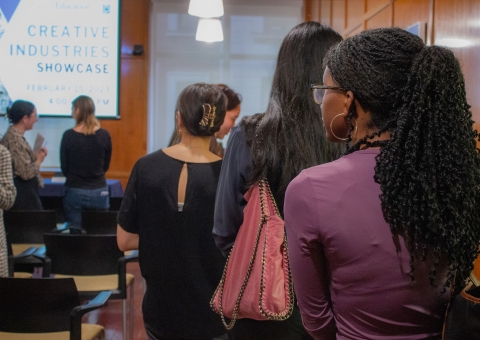The term “arts industry” encompasses a wide variety of fields. All careers within the arts involve highly creative aspects. Professionals in these fields possess artistic vision, a deep appreciation for design and a clear aesthetic. There is no typical career path or work day for an artist—each aspect of this industry offers different opportunities.
INDUSTRY INSIGHTS
Explore the list of industry guides on Vault (formerly Firsthand) to access exclusive information about this industry.
SAMPLE EMPLOYERS IN LIONSHARE
- Rubin Museum of Art
- The Rye Arts Center
- The Metropolitan Museum of Art
- Public Art Fund
- Chelsea Film Festival
Focus Areas in the Arts
Here is a sample list of applied areas in this industry:
ARCHITECTURE
Architects create buildings for clients, ensuring that the structures they design are safe and functional and that they suit the aesthetic preferences of their clients. This occupation requires extensive study; typically, architects must earn a bachelor’s degree, and then pursue a master’s program of two to four years.
ARTS MANAGEMENT
Arts management is the business-oriented facet of the art world and encompasses the logistical side of non-profit arts organizations, such as museums, theatres and galleries, in order to ensure that they continue to operate. People involved in the arts management field apply their passion for the arts to their work, as they plan events, hold fundraisers, run marketing and advertising campaigns and coordinate exhibitions to ensure the continued popularity of their clients.
FASHION
If you have a sartorial eye and a creative mind, a career in fashion could prove enormously fruitful. The glitz and the glamour of haute-couture runway shows, exposure to cultural icons, and the ability to determine style attracts many would-be tastemakers; those successful enough to break through the steep entry barriers, however, recognize that the industry requires sharp business acumen as well. Career paths include: Design, Merchandising, Styling, and Marketing.
VISUAL ARTS
Whereas performing artists use their bodies to produce an ephemeral artwork, visual artists use their skills to create tangible products. Paint-splattered canvases, sculpted vases, architectural steel mobiles, woven tapestries, crystalline photographs of natural landscapes—all of these are works of visual artists. Visual artists work to transform the everyday into the beautiful. Unless visual artists seek stable employment in a related field, they will not adhere to recruiting timelines. Thus, production of artworks is often constant, as artists seek their “big break.” Alternatively, artists can often find stable employment through the commercial arts, which involves artistic production for clients. Visual artists can also apply their skills in related creative fields, including advertising, education and journalism.
MUSIC
While the word “music” may conjure images of Jimi Hendrix playing the Star-Spangled Banner at Woodstock, or Ella Fitzgerald crooning blues tunes on stage, the music industry extends far beyond the performers who tug at our ears and heartstrings. Musicians are supported by an extensive network of individuals who ensure that their talent is discovered and appreciated, from music publishers to producers to publicists. Given the seemingly endless variety of music being produced today, there are multiple ways to become involved in the music industry.
PERFORMING ARTS
The word “performer” generates notions of Hollywood and Broadway, but the performing arts industry is much more than the glitz and glamour associated with celebrity culture. Performing artists are, first and foremost, artists; their success is predicated upon their craft, be it acting, dance or comedy, that they have honed over countless hours of practice. While the potential to achieve stardom attracts countless performers to performing arts careers, only those with the determination to spend years refining their skills, while often enduring difficulties such as rejection, gain self-sustaining careers in the performing arts.
GRAPHIC ARTS
Design hybridizes artistry with technical skill, as designers combine artistic elements such as form, color and texture in order to create products that appeal to the target audiences of their clients. Like the fine arts, design can be seen virtually everywhere, from the cover of magazines at the newsstand (graphic design) to the interfaces of the webpages which you visit on a daily basis (web design) to the distinctive aesthetic styles of homes and businesses (interior and lighting design). As such, the diversity of opportunities available in the design industry is enormous, and each position varies in its day-to-day duties. Careers in design all require creative vision, and designers can all gain the ability to make a stable, sustainable living based upon the products they create for the clients they serve.
MUSEUMS
For those dedicated to the preservation of works of art, a career at a museum could be the perfect fit. Museums are institutions of various sizes meant to maintain and exhibit works of art for both academic purposes and aesthetic enjoyment. While professionals of many types, from grant writers to publicists to educators, can work at museums, two career paths in particular are unique to the museum context: art preservation and curating.
Columbia University Resources
- Read a recap of Alumnus Indira Cesarine’s tips that she shared at the Columbia College Dinner and Discussion Series.
- Check out what we have learned about this industry in our blog like Leveraging a Passion in the Arts: Site Visit & Tour of the Rubin Museum of Art.
- Read some highlights from Insider Info on Companies like the Lincoln Center for the Performing Arts, The Metropolitan Museum of Art, and other organizations in the arts.
- See recent grads’ post-grad plans and transferable skills with our tipsheets on Arts majors.
- Connect to the arts in New York City at the Arts Initiative at Columbia.








